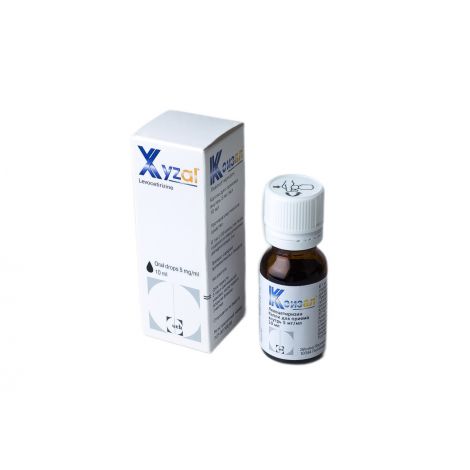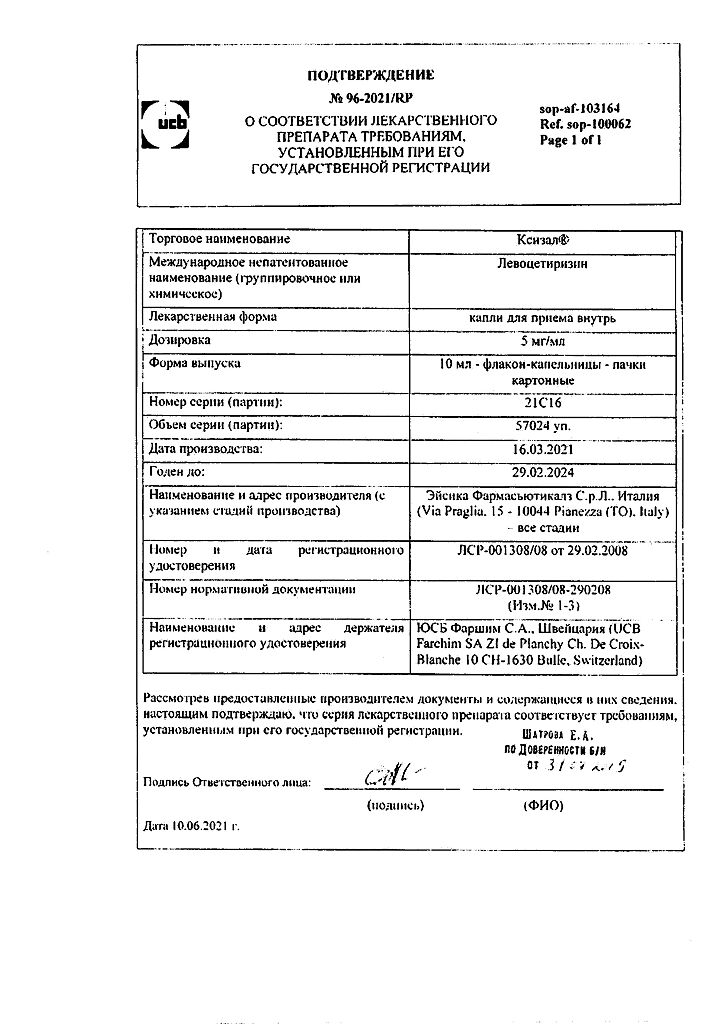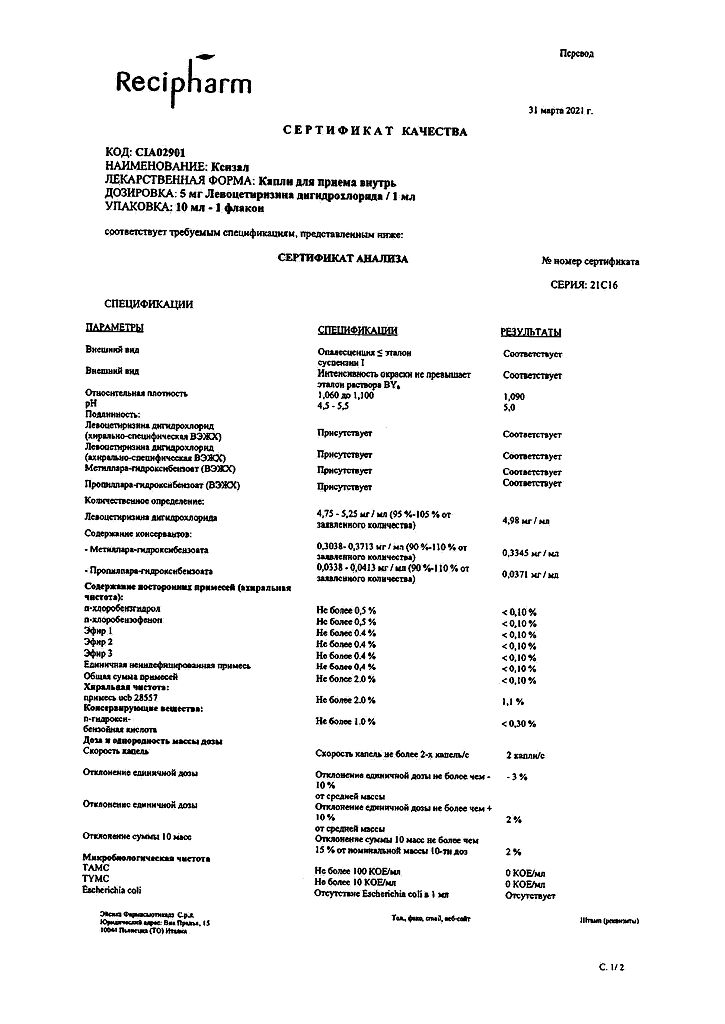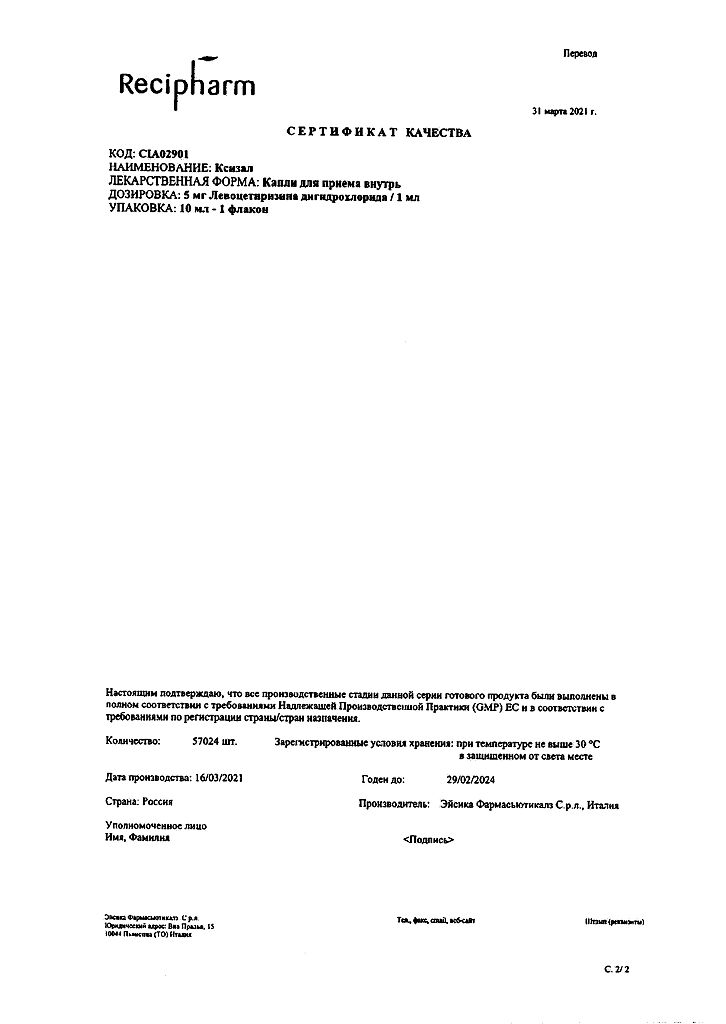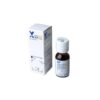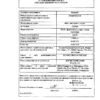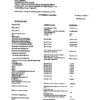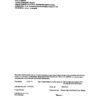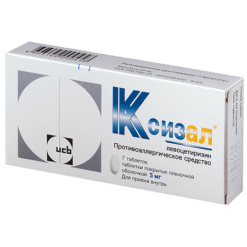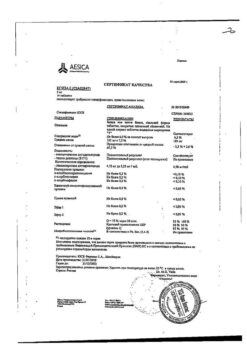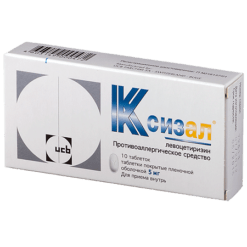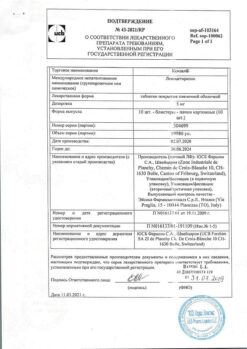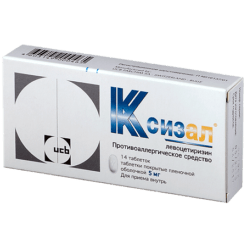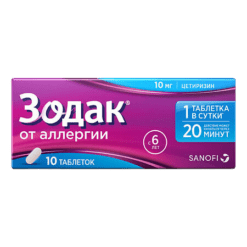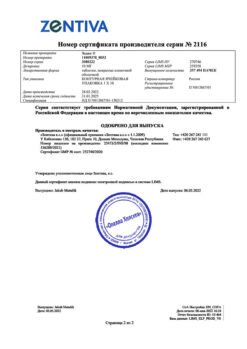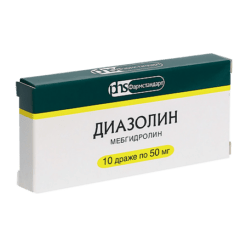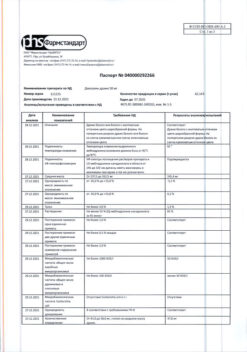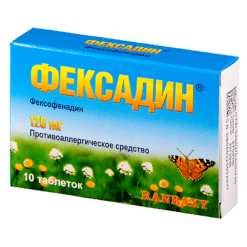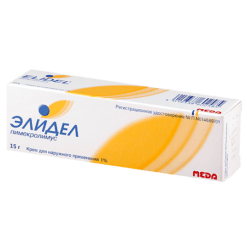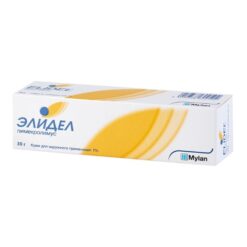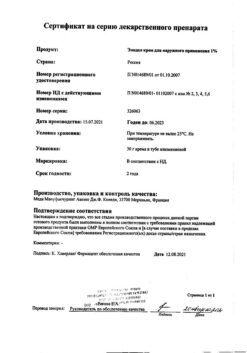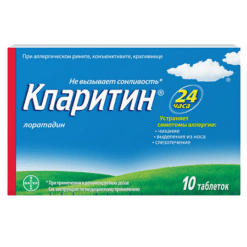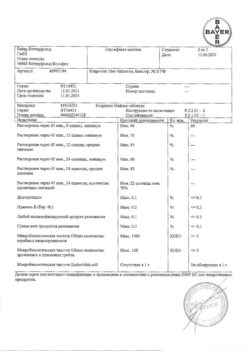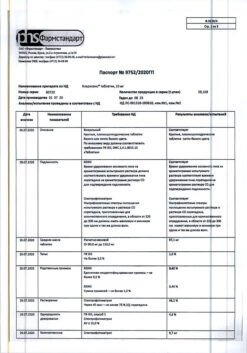No products in the cart.
Description
Anti-allergic agent -H1-histamine receptor blocker.
ATC code: R06AE08.
Pharmacological properties
Pharmacodynamics. Levocetirizine – the active substance of Xizal® is R-enantiomer of cetirizine, which belongs to the group of competitive histamine antagonists and blocks H1-histamine receptors. Levocetirizine has twice the affinity to H1-receptors as cetirizine.
Levocetirizine influences the histamine-dependent stage of allergic reactions, also reduces migration of eosinophils, decreases vascular permeability and limits the release of inflammatory mediators. Levocetirizine prevents the development and facilitates the course of allergic reactions, has antiexudative, antipruritic action, it has practically no anticholinergic and antiserotonin action. In therapeutic doses it has practically no sedative effect.
Pharmacokinetics. Pharmacokinetic parameters of levocetirizine change linearly and practically do not differ from the pharmacokinetics of cetirizine. Absorption. After oral administration, the drug is quickly and completely absorbed from the gastrointestinal tract. Food intake does not affect the completeness of absorption, although its rate is reduced.
In adults after a single therapeutic dose (5 mg) the maximum concentration (Cmax) in plasma is reached after 0.9 h and is 270 ng/ml, after re-administration of 5 mg/day – 308 ng/ml. Permanent level of concentration is reached after 2 days. Distribution. Levocetirizine is 90% bound to plasma proteins. Volume of distribution (Vd) is 0.4 l/kg. Bioavailability reaches 100%.
Metabolism. In small amounts (< 14 %) it is metabolized in the body by N- and O-dealkylation (unlike other Hg histamine receptor antagonists, which are metabolized in the liver via the cytochrome system) to form a pharmacologically inactive metabolite. Due to the low level of metabolism and lack of metabolic potential, interaction of levocetirizine with other drugs seems unlikely.
Elimation. In adults the elimination half-life (Tsh) is (7.9 ± 1.9) h; in young children the T 1/2 is shorter. In adults, the total clearance is 0.63 ml/min/kg. About 85.4% of the administered dose of the drug is excreted unchanged by the kidneys through tubular filtration and tubular secretion; about 12.9% – through the intestine.
In patients with renal insufficiency (creatinine clearance (CK) < 40 ml/min) the drug clearance decreases and Tc prolongs (thus, in patients on hemodialysis the total clearance decreases by 80%), which requires appropriate changes in dosing regimen. Less than 10% of levocetirizine is removed during a standard 4-hour hemodialysis procedure.
Indications
Indications
Symptomatic treatment of allergic diseases and conditions:
year-round (persistent) and seasonal (intermittent) allergic rhinitis and allergic conjunctivitis (itching, sneezing, rhinorrhea, lacrimation, conjunctival hyperemia, nasal congestion);
hay fever (hay fever);
urticaria (including chronic idiopathic urticaria);
Quincke’s edema;
other allergic dermatoses, accompanied by itching and rashes.
Pharmacological effect
Pharmacological effect
Antiallergic agent – H1-histamine receptor blocker.
ATX code: R06AE08.
Pharmacological properties
Pharmacodynamics. Levocetirizine, the active substance of Xyzal®, is the R-enantiomer of cetirizine, which belongs to the group of competitive histamine antagonists and blocks H1-histamine receptors. The affinity for H1 receptors of levocetirizine is 2 times higher than that of cetirizine.
Levocetirizine has an effect on the histamine-dependent stage of allergic reactions, and also reduces the migration of eosinophils, reduces vascular permeability, and limits the release of inflammatory mediators. Levocetirizine prevents the development and facilitates the course of allergic reactions, has an antiexudative, antipruritic effect, and has virtually no anticholinergic and antiserotonin effects. In therapeutic doses it has virtually no sedative effect.
Pharmacokinetics. The pharmacokinetic parameters of levocetirizine change linearly and are practically no different from the pharmacokinetics of cetirizine. Suction. After oral administration, the drug is quickly and completely absorbed from the gastrointestinal tract. Eating does not affect the completeness of absorption, although its speed decreases.
In adults, after a single dose of the drug in a therapeutic dose (5 mg), the maximum concentration (Cmax) in the blood plasma is reached after 0.9 hours and is 270 ng/ml, after repeated administration at a dose of 5 mg/day – 308 ng/ml. A constant level of concentration is achieved after 2 days. Distribution. Levocetirizine is 90% bound to plasma proteins. The volume of distribution (Vd) is 0.4 l/kg. Bioavailability reaches 100%.
Metabolism. In small quantities (<14%) it is metabolized in the body by N- and O-dealkylation (unlike other Hg histamine receptor antagonists, which are metabolized in the liver using the cytochrome system) to form a pharmacologically inactive metabolite. Due to its low metabolic rate and lack of metabolic potential, interactions between levocetirizine and other drugs are unlikely.
Excretion. In adults, the half-life (Tw) is (7.9 ± 1.9) hours; in small children T 1/2 is shortened. In adults, the total clearance is 0.63 ml/min/kg. About 85.4% of the administered dose of the drug is excreted unchanged by the kidneys through barrel filtration and tubular secretion; about 12.9% – through the intestines.
In patients with renal failure (creatinine clearance (CC) < 40 ml/min), the clearance of the drug decreases and Tg lengthens (for example, in patients on hemodialysis, the total clearance decreases by 80%), which requires a corresponding change in the dosage regimen. Less than 10% of levocetirizine is removed during a standard 4-hour hemodialysis procedure.
Special instructions
Special instructions
Caution is required when used simultaneously with alcohol (see Interactions with other drugs).
Impact on the ability to drive vehicles and operate machinery
An objective assessment of the ability to drive vehicles and operate machinery did not reliably reveal any adverse events when taking the drug at the recommended dose. But, nevertheless, during the period of taking the drug, it is advisable to refrain from engaging in potentially hazardous activities that require increased concentration and speed of psychomotor reactions.
Active ingredient
Active ingredient
Levocetirizine
Composition
Composition
1 ml contains:
Active substance:
Levocetirizine dihydrochloride 5 mg.
Excipients:
sodium acetate, acetic acid,
propylene glycol,
glycerol 85%,
methyl parahydroxybenzoate,
propyl parahydroxybenzoate,
sodium saccharinate,
purified water.
Pregnancy
Pregnancy
Experimental studies in animals have not revealed any direct or indirect adverse effects of levocetirizine on the developing fetus, as well as on development in the postnatal period; the course of pregnancy and childbirth also did not change.
Adequate and strictly controlled clinical studies on the safety of the drug during pregnancy have not been conducted, therefore levocetirizine should not be prescribed during pregnancy.
Levocetirizine is excreted in breast milk, so its use is only possible if the expected benefit to the mother outweighs the potential risk to the baby.
Contraindications
Contraindications
Hypersensitivity to any of the components of Xyzal or piperazine derivatives;
severe form of chronic renal failure (Cl creatinine
children under 6 years of age.
With caution:
chronic renal failure (dosage regimen adjustment required);
old age (possibly decreased glomerular filtration rate).
Use during pregnancy and breastfeeding
It is not recommended for use in women during pregnancy and breastfeeding.
Side Effects
Side Effects
Possible side effects are listed below by body system and frequency of occurrence: often (≥1/10); uncommon (from ≥1/100 to <1/10); rare (from ≥1/1000 to <1/100); very rare (from ≥1/10,000 to <1/1000).
From the side of the central nervous system: infrequently – headache, fatigue, drowsiness; rarely – asthenia; very rarely – aggression, agitation, convulsions, hallucinations, depression, visual impairment.
From the cardiovascular system: very rarely – tachycardia.
From the respiratory system: very rarely – dyspnea.
From the digestive system: infrequently – dry mouth; rarely – abdominal pain; very rarely – nausea, diarrhea, hepatitis, changes in liver function tests.
From the musculoskeletal system: very rarely – myalgia.
Metabolism: very rarely – weight gain.
Allergic reactions: very rarely – itching, rash, urticaria, angioedema, anaphylaxis.
Interaction
Interaction
The interaction of levocetirizine with other drugs has not been studied.
When studying the drug interactions of cetirizine racemate with pseudoephedrine, cimetidine, ketoconazole, erythromycin, azithromycin, glipizide and diazepam, no clinically significant adverse interactions were identified.
When administered simultaneously with theophylline (400 mg/day), the total clearance of cetirizine is reduced by 16% (the kinetics of theophylline does not change).
In some cases, when levocetirizine is used concomitantly with alcohol or drugs that depress the central nervous system, their effect on the central nervous system may be enhanced, although it has not been proven that cetirizine racemate potentiates the effect of alcohol.
Overdose
Overdose
Symptoms: drowsiness (in adults), agitation and anxiety, followed by drowsiness (in children).
Treatment: immediately after taking the drug orally, it is necessary to rinse the stomach or induce artificial vomiting.
It is recommended to prescribe activated carbon and carry out symptomatic and supportive therapy.
There is no specific antidote.
Hemodialysis is not effective.
Storage conditions
Storage conditions
In a place protected from light, at a temperature not exceeding 30 °C
Shelf life
Shelf life
3 years
Manufacturer
Manufacturer
UCB Farma, Belgium
Additional information
| Shelf life | 3 years |
|---|---|
| Conditions of storage | In a light-protected place, at a temperature not exceeding 30 °C |
| Manufacturer | UCB Farma, Belgium |
| Medication form | oral drops |
| Brand | UCB Farma |
Other forms…
Related products
Buy Xizal, drops 5 mg/ml 10 ml with delivery to USA, UK, Europe and over 120 other countries.

